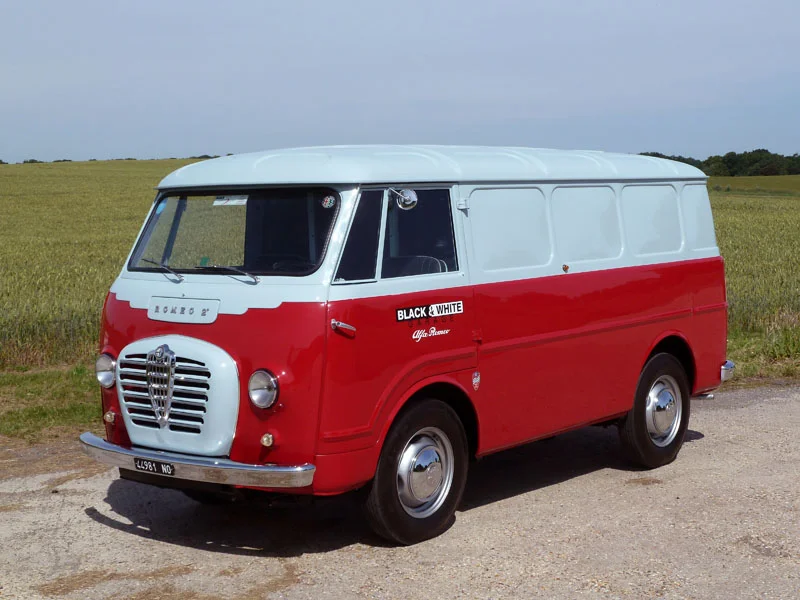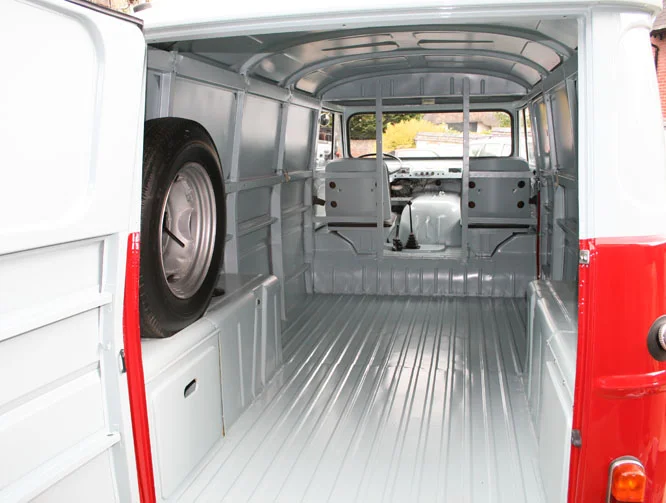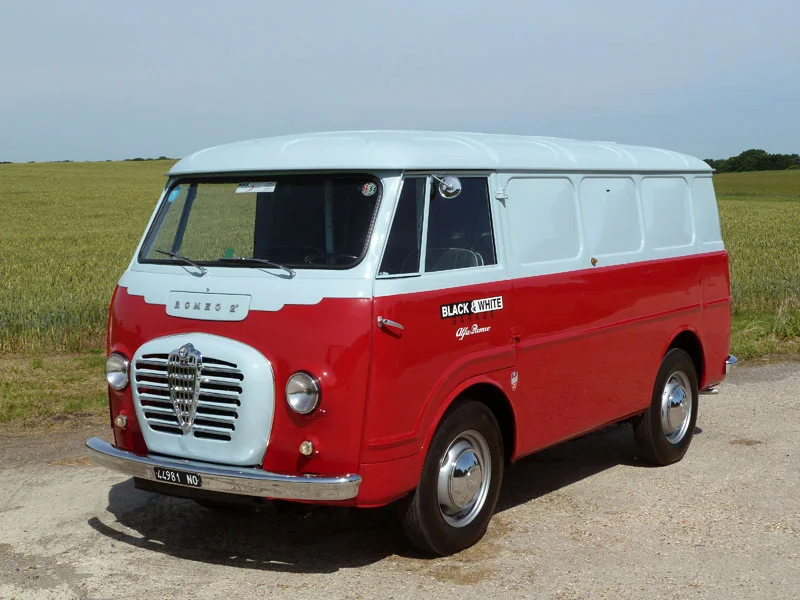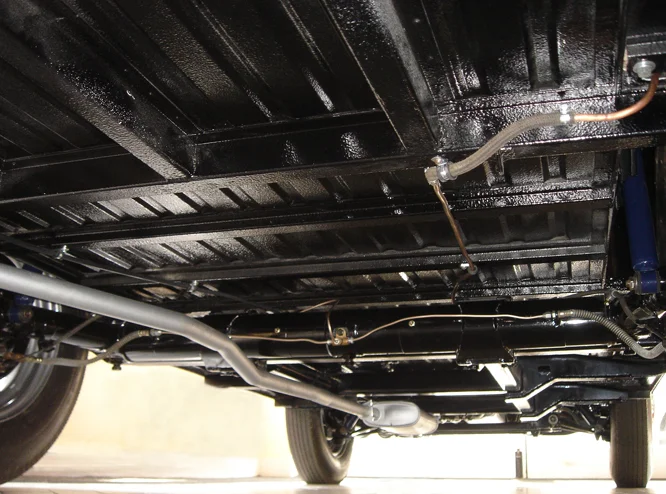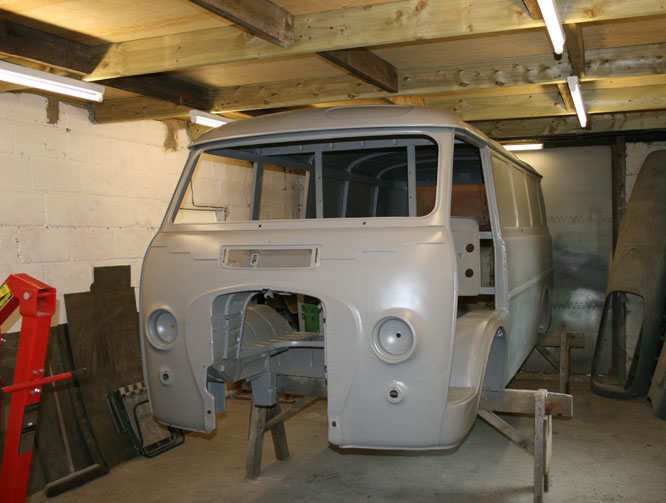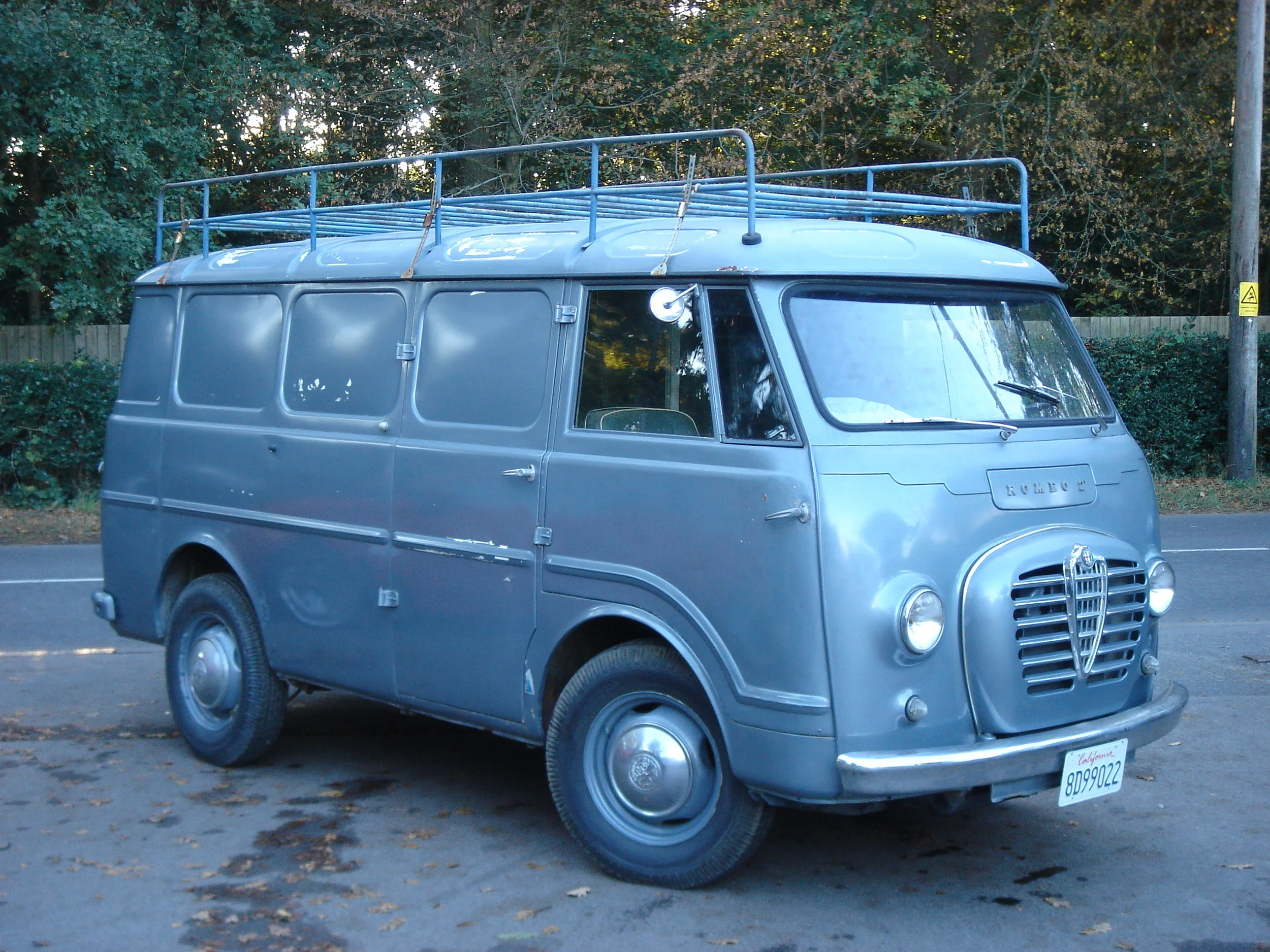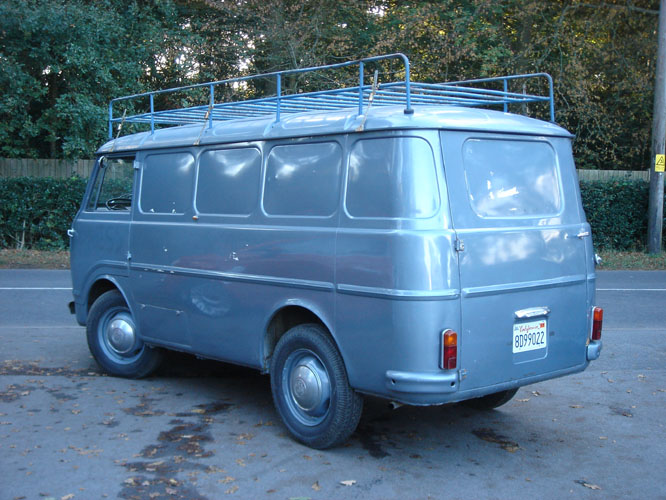1957 Alfa Romeo Romeo 2 Furgone
1957 Alfa Romeo Romeo 2 Furgone
SOLD
Engine: 1290cc twin-cam four cylinder
Transmission: 4 Speed manual FWD
Year: 1957
Registration: 127 XUU
Mileage: 55,000
Exterior Colour: Alfa red and spring water grey
Interior colour and material: Black leather piped grey
- This Exceptionally rare Alfa Romeo commercial vehicle joined our Black & White Collection in August 2007, but was sadly sold in January 2014 due to a lack of use and storage space difficulties.
- According to the Alfa Romeo Museum archives this Romeo 2 was manufactured on September 11th 1957 in Alfa Romeos factory in Pomigliano d'Arco, near Naples in southern Italy, and sold new on October 2nd 1957 in Briona in the province of Novara, northern Italy, just west of Milano. This Romeo 2 Furgone (van) remained in that area with only four owners until 1998 when it was sold to an English Gentleman living in Los Angeles, California.
- On arriving at The Port of Los Angeles in July 1998 it joined his 110 plus European car, bus, commercial vehicle and motorcycle collection to be hired out to the Hollywood movie studios for use when creating European street movie scenes.
- After a two year search by us for a Romeo 2 or F12 van, this Romeo 2 was found and purchased sight unseen on August 24th 2007 through American eBay. We had it shipped back to England in a container by Kingstown-Shipping.co.uk, with our first viewing being when we collected it from Felixstowe Port on October 16th 2007.
- It is believed (at the time of writing) to be the only full panel (no side or rear windows) Romeo 2, F11 or F12 in the United Kingdom, and is complete with the exceptionally rare factory option of a full roof rack which it has worn since new.
- The odometer reading of 88,000 kilometres (55,000 miles) is believed to be genuine based on the amazing and remarkably original condition of the chassis and body.
- The original colours of the van are believed to be cream with a mid-blue roof, nose and lower section.
- In January 2008 the van commenced a complete nut-and-bolt body-off-chassis restoration by John Holden at Pure Bodies, near Andover, Hampshire. The Alfa Romeo period correct exterior colours chosen were Alfa Red (AR501) for the lower body section (below the side windows) with a light grey (AR701 - Acqua di fonte = Spring Water) upper body section, roof, and grille. The interior colour is also AR701 but with a satin finish. All of the paintwork was carried out by Sean Watson. The seats were trimmed in black leather with light grey piping by TA & JM Coburn of Swindon. The chassis, underside of the floor, and the wheel arches are black. Mechanically the van is standard, just as it left the factory.
- The restoration was finished in June 2009 with UK road registration being granted in the same month.
- On July 3rd 2009 the Romeo 2 was granted with FIVA Papers (Federation Internationale des Vehicules Anciens). FIVA Papers are granted on vehicles "which are accepted as being an important part of our industrial heritage" and are also proof of how the vehicle compares to it's original factory specification.
- In November 2009 the Romeo 2 was registered with RIAR (Registro Italiano Alfa Romeo) at the Automobilismo Storico Alfa Romeo (Alfa Romeo Museum) in the old factory grounds at Arese, Milano.
- Originally registered in Italy as NO 44981, then in California as 8D99022, and now in England as 127 XUU.
Events we have exhibited this Alfa Romeo at:
- NEC Classic Motor Show, NEC, Birmingham, West Midlands, November 9th to 11th 2007 - prior to restoration.
- Cotswold Alfa Day, Sudeley Castle, Gloucestershire, June 28th 2009 - post restoration debut.
- Silverstone Classic, Silverstone Motor Circuit, Northamptonshire, July 26th 2009 - displayed on the Scuderia del Portello paddock stand.
- Goodwood Road Racing Club Annual Vehicle Display, Goodwood House, West Sussex, August 9th 2009 - 2nd place (by two votes) in the People's Choice award.
- Auto Italia Magazine Italian Car Day, Gaydon, Warwickshire, September 6th 2009.
- Classic and Sportscar Magazine Thatcham Classic, Berkshire, October 10th 2009.
- Manor Farm Fly In historic air craft day, West Berkshire, July 14th 2011.
A brief history of small Alfa Romeo commercial vehicles:
Few people realise that Alfa Romeo, the historical and charismatic marque that has built some of the finest and most beautiful cars, made a competent range of hard working commercial vehicles in their varied past. In fact, they used to be the oldest commercial vehicle manufacturer in Italy after the mighty FIAT.
Many manufacturers were forced to diversify during the war years and Alfa Romeo was no exception. As well as continuing its car and lorry production it added stationary engines, tractors, and some household appliances to its catalogues, including a few kitchen stoves of which just two are known to survive in the world.
Alfa Romeo produced its first commercial vehicle in 1914 with a lorry based on the 20/30hp car chassis. Many lovely trucks followed and were produced with Alfa Romeo’s typical Italian design flair, but by the late 1940’s the car and commercial vehicle production lines at Alfa Romeo’s Portello factory on the outskirts of Milan began to trip over each other, so the company expanded its production facility in southern Italy at Pomigliano d’Arco near Naples where they manufactured aircraft engines, and relocated commercial vehicle production there in 1948.
The Alfa Romeo Camion (truck) brochure offered a range of large trucks in all shapes and sizes to suit the demanding and various needs of the commercial vehicle purchaser, some bodied by the factory and others by creative coachbuilders who were able to produce almost whatever the client required. Some of the specialist body styles were just as beautiful as the exotic cars of the time, as could only be achieved in Italy.
Alfa Romeo produced a range of large trucks in all shapes and sizes to suit the demanding and various needs of the commercial vehicle purchaser. Their most popular derivatives of the 1950’s were the 450 and 900 series which were produced from 1950 until 1959. The Mille was then introduced as its replacement but it was not well received by potential buyers. Customer expectations were getting higher and the competition from the likes of FIAT, Lancia, and OM were getting tougher. The Mille was troubled by reliability issues and its 10,000cc six cylinder diesel engine (later 11,000cc) proved to be underpowered and unreliable. Despite the Mille being a fine looking machine with a larger version of the beautiful Giulietta grille adorning its curvy front, production was to end in 1964, just six years after it was introduced.
What Alfa Romeo really needed was a smaller commercial vehicle, so the early 1950’s saw the design and development of something smaller than their current offerings. Launched in early 1954, the "Romeo" was produced alongside the larger Alfa Romeo trucks at the Pomigliano d’Arco factory, and was the first Alfa Romeo commercial vehicle to be made only with left hand drive steering, all other Alfa Romeo trucks having had right hand drive steering. Amazingly this vehicle in all its derivatives and models would be produced until 1983.
The Romeo was rather revolutionary as the petrol engine that powered it was the twin overhead camshaft 1,290cc aluminium unit from the Giulietta road car, and if that wasn’t unusual enough, the engine’s 37 horse power was delivered through a four speed ZF gearbox to the front wheels. A diesel engine was offered which was equally unorthodox being a supercharged two cylinder unit, but it proved to be unpopular.
Alfa Romeo was not immune to placing detuned versions of its wonderful twin-cam engines into vehicles in which you would not expect to find them. With the rumour circulating in 1951 of Fiat designing a Land Rover style vehicle for the Italian Army, Alfa Romeo designed and produced the 1900M AR51 in just over a year. AR stood for Autovettura da Ricognizione which translates to Reconnaissance Car, and the engine was the twin-cam 1,884cc petrol unit usually found in the 1900 Berlina and Sprint. Sadly they cost too much and after the Italian Army acquired their first batch in 1952 they switched to using the cheaper FIAT Campagnola. Only 2,011 AR51’s were manufactured in 1952 and 1953 and there was an AR52 launched in 1954 of which just 154 were built, but it is unsure whether this was simply an updated version of the AR51 or a civilian version (as the Army had cancelled their contract). These were hugely capable machines and their go-anywhere abilities soon gained them the nickname “Matta”, roughly translating as “crazy” in recognition of their extraordinary capabilities.
Returning to the subject of the Romeo van, numerous body styles were offered by the factory to suit the needs of most purchasers, but if something more tailored or elaborate was required then a chosen carrozzeria could have provided minibuses, car transporters, advertising units, and mobile market stalls, to name just a few.
In 1956 the Romeo was replaced by the Romeo 2 which was visually identical except for the badging, and the model range was also unchanged. In 1966 the third series of the Romeo was introduced, and although it really should have been called the Romeo 3, it was in fact just known as the Romeo. Production lasted for only about six months or so and differences between it and the Romeo 2 were mainly the adoption of an adjustable driver’s seat, and a hydraulic clutch rather than a cable one.
In 1967 the front panel of the Romeo 3 was updated with a wider chrome and mesh grille and became known as the A12 (A for autocarri - truck cab version with open chassis) and F12 (F for furgoni chiusi - closed van version). The 1290cc engine now had 52 hp and in 1973 a four cylinder Perkins Diesel engine was also offered, as fitted to the Giulia Saloon.
Between 1967 and 1971 two models were available alongside the A12 and F12 named the A11 and F11. These were visually identical to the A12 and F12 but had a lighter payload and a lower engine horsepower. Some Italian cities stipulated the carrying capacity and horsepower of commercial vehicles had to be below certain amounts for them to be allowed into the city centre, and therefore the 11’s were allowed into places the 12’s were not.
The final incarnations of the A and F series vehicles were launched in 1977 and featured black plastic grilles instead of the chrome and metal ones of the earlier models, and the chrome badges were replaced by black stickers. Production sadly ceased in 1983, however, available from the late 1970’s was an Iveco Daily based Alfa Romeo AR8 which was a joint venture with Fiat, Iveco, and OM. It’s early 1980’s replacement was based on the Fiat Ducato and was a result of a collaboration between Fiat, Peugeot, and Citroen. Badged the AR6, it was also the last Alfa Romeo commercial vehicle, and when the Fiat Group purchased Alfa Romeo in 1986, production of Alfa Romeo AR6’s was reduced and then finally stopped in 1988.
The Romeo and later A12/F12 ranges were also manufactured in Spain by a company called FADISA (Fabricacion de Automoviles Diesel SA) under licence from Alfa Romeo. Fadisa’s logo on the grille badge was very similar to Alfa Romeo’s and had Fadisa at the top and Lic. Alfa Romeo at the bottom. The early Romeo variants manufactured in Avila from 1959 were badged as “ROMEO” (as were the Alfa Romeo produced ones), however there were two further badges on the front panel below the windscreen showing FADISA on one side and AVILA on the other. Later versions had a 3-bar grille (rather than six) and “Romeo Fadisa” badging. Coinciding with Alfa Romeo’s launch of the A12/F12 range in 1967 was Fadisa’s absorption into Spain’s Motor Iberica Group. The new owners followed Alfa Romeo’s launch and introduced the A12/F12 bodied vehicles but named them the Ebro F100. They were almost visually identical to the Alfa Romeo variants, with a notable difference being the use of earlier Romeo style wheels due to the retention of the Romeo’s drum brakes (the Alfa Romeo’s now had disk brakes at the front). In 1971 the F100 was replaced by the F108 and featured oblong headlights as opposed to the round ones fitted to the F100’s, A12’s, and F12’s, and production would continue until 1976 when Ebro replaced the F108 with a Nissan derived van.


